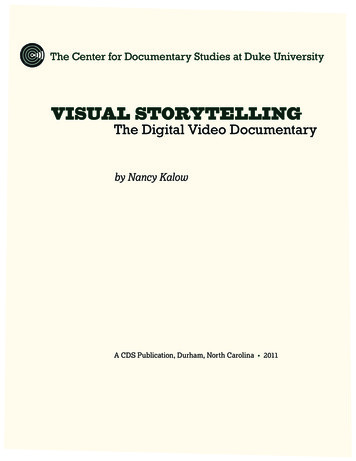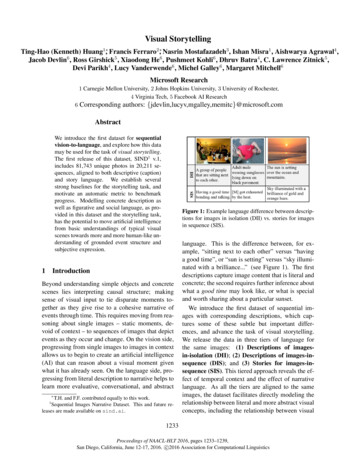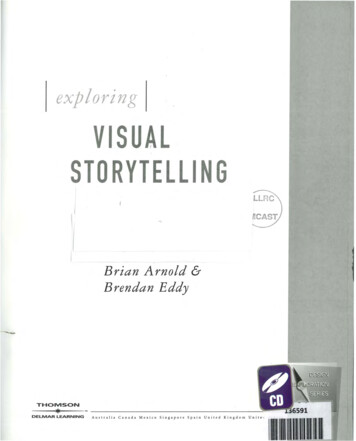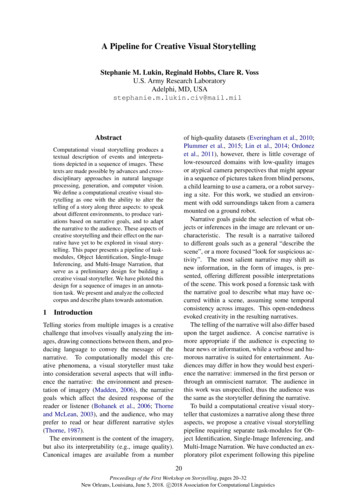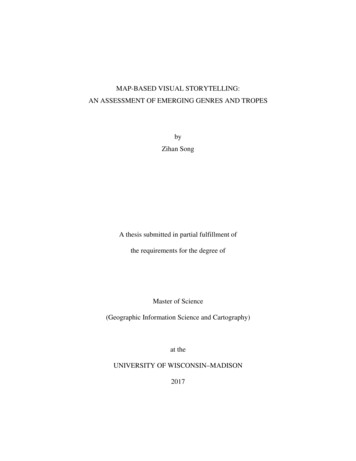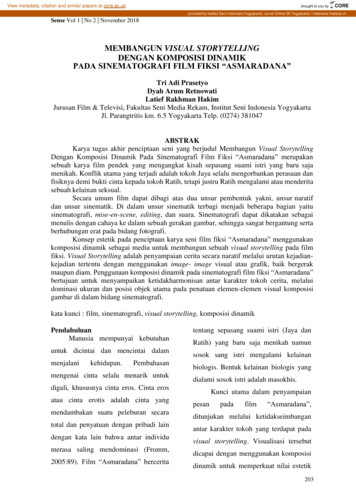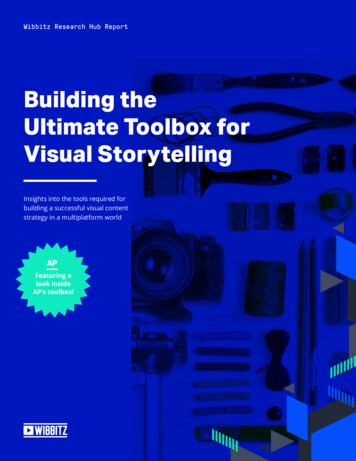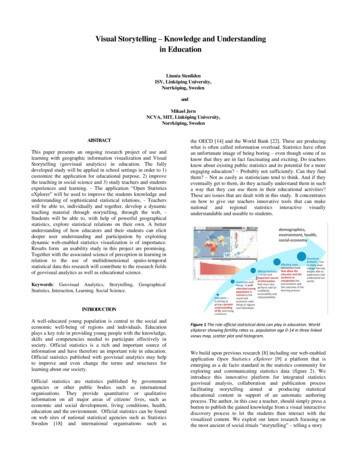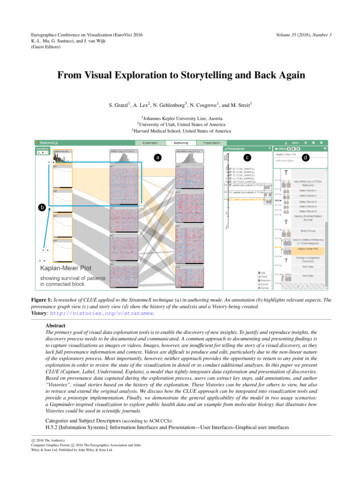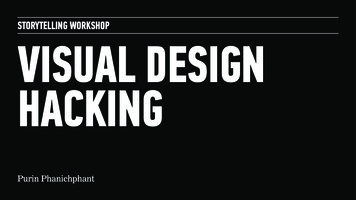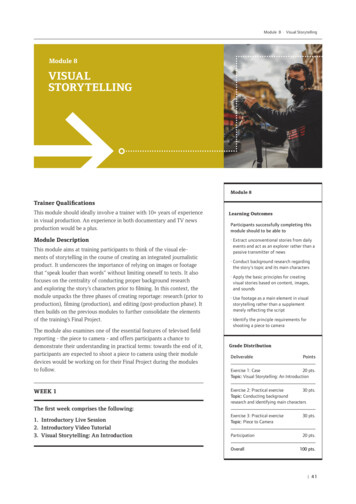
Transcription
International Journal of Humanities Social Sciences and Education (IJHSSE)Volume 7, Issue 10, October 2020, PP 118-127ISSN 2349-0373 (Print) & ISSN 2349-0381 www.arcjournals.orgVisual Storytelling in Advertising: A Study of Visual Storytellingas a Marketing Approach for Creating Effective AdsDoaa Farouk El-Desouky*Associate Professor, Faculty of Mass Communication, Advertising & PR Department, Ahram CanadianUniversity. Egypt.*Corresponding Author: Doaa Farouk El-Desouky, Associate Professor, Faculty of MassCommunication, Advertising & PR Department, Ahram Canadian University. Egypt.Abstract: Visual stories are a powerful and effective method of communicating ideas, wisdom, culturalknowledge and historical events. The rise of visual social media platforms has also resulted in the presenteconomy in which the consumers welcome real-time marketing in the form of "snack able" bits of visualcontent. Accordingly visual storytelling has become a potent force in content marketing as brands have foundit imperative to include visual content and narratives into their marketing agenda. With the rise of visualstorytelling as a contemporary effective way of communicating & marketing ideas to the public, here emergedthe importance & significance of this paper discussing visual storytelling in advertising as a marketingapproach that can help creating effective & powerful ads. The paper follows the descriptive research methodsin discussing visual storytelling as a marketing approach for creating effective ads & the demonstration ofadvertising samples using visual storytelling as a strategy.Key words: Visual Storytelling, Communication, Marketing, Advertising, Media.1. INTRODUCTIONBefore the days of neon lights and marquee signs, business owners had to get creative when it came toadvertising their establishments. In fact, wine bars in ancient Rome used to hang a bunch of vineleaves outside their door as a nod to the God of Wine, Bacchus. And when weather conditions leftthem with a short supply of vine leaves, barkeeps turned to bushes - inns called bush - & bushes, stillexist today.But others didn’t even have that. They had to get artistic. And with a largely illiterate population,pictorial signs were the only logical advertising choice.Visual storytelling -- or passing on a lot of information through a relatively simple visual aid -- hasbeen a cornerstone of marketing for thousands of years, and still what worked then works now. Wesee what we want and we’re driven to buy it,and if anything has changed it's more of the purpose, astoday’s visual storytellers have a chance to lead the consumer into a whole new world ofpossibilities.[1] (De Meré, 2016)2. WHAT IS VISUAL STORYTELLING?By definition, visual storytelling might seem pretty straightforward — it’s the art of communicating aseries of messages using visual media. The concept isn’t new to our cultural landscape. In fact, thephrase ―A picture is worth a thousand words‖ was coined just after the turn of the 20th Century.[2](Scherman, 2016)But the concept of visual storytelling is more relevant now than ever, especially in our highly digitalage in which there is a constant battle for consumers’ attention.Another definition is: ―Visual storytelling involves the use of graphics, images, pictures, and videos toengage with viewers in an effort to drive emotions, engage inter-communication, and motivate anaudience to action.‖[3] (Shiao, 2020)Today’s visual storytelling involves the use of graphics, images, pictures and videos to engage withviewers in an effort to drive emotions and interaction. These are tactics marketers have been tunedInternational Journal of Humanities Social Sciences and Education (IJHSSE)Page 118
Visual Storytelling in Advertising: A Study of Visual Storytelling as a Marketing Approach for CreatingEffective Adsinto for years, but with the rapid rise in digital marketing, they’re now calling upon designers to bringtheir messages to life. Talented designers are essential in presenting data and messaging in visualformats, which is critical to visual storytelling. Once they have all the necessary details, designers aretasked with turning information into relevant, informative, eye-catching pieces of art. Chief amongthese formats is video, but visual storytelling can include everything from compellingphotojournalism and educational info-graphics to cutting-edge comics, GIFs and memes.Visual storytelling isn't about pairing a piece of content with an image; it’s about determining theright way to represent the information to ensure that it is compelling and relevant for the rightaudience. When the visual aspect is at its most powerful, the impact and performance of the content ismagnified. [2](Scherman, 2016)Visual storytelling starts with a story. A story is the telling of an event or series of events via anymedium and in any way, e.g., written, verbal, with images, via TV, via radio, via social media, etc. Avisual story is a story with the explicit use of visuals to convey that story.Visuals in themselves are powerful. Images are for example much more powerful than plain text. Agreat story is a powerful way to communicate, and adding images to that story strengthens themessage even more.3. THE EVOLUTION OF VISUAL STORYTELLINGVisual storytelling has not been an overnight sensation, but instead it has been the result of acontinued evolution of social media platforms, along with user and company behaviors. From the late1990s to mid-2000s, sites such as blogging platforms, MySpace, Delicious (formerly Del.icio.us),Flickr, and Facebook created early opportunities for visual engagement. If you look closely at theseplatforms, you’ll see that all of them were created in response to the massive flow of content on theInternet, much of which was visual.Besides the content shared, perhaps one of the most important qualities these early social mediaplatform leaders had was the ability to bring like-minded individuals together online. Just as today,when there are so many social media platforms to engage on, like-minded individuals always seemedto find their way into the online communities that best reflected their interests. The key then, as it isnow, was to identify what brings people to a social media platform, understand what value they derivefrom the platform, and determine how your company could fit within those engagement bestpractices.In addition to community engagement, the activity on these platforms also reinforced that users werelooking for ways to easily share and organize content, imagery, visuals, and videos.[4](Walter &Gioglio, 2014)4. WHY IS VISUAL STORYTELLING SO IMPORTANT?The telling of a story lies deep in the social behavior of human groups - ancient and modern. Theydramatize social relations and problems of living, convey ideas or act out of fantasies. Thus the tellingof a story requires skill. Storytelling preserved knowledge by passing it from one generation toanother and this mission has continued into modern times. The early storytellers used crude imagessupported with gestures and vocal sounds which later evolved into language. And over the centuriesas technology provided paper, printing machines & electronic transmitters till entering the digital age,these developments directly affected the narrative arts.[5] (Eisner, 2008)5. VISUAL STORYTELLING THAT MAKES THE BIGGEST IMPACTAll forms of visual storytelling usually provide credible statistics, but it shouldn’t surprise you thatvideo is king when it comes to the most impactful format. While video may be king, it’s not the onlytype of visual storytelling audiences want. Regardless of format, all forms of visual storytellingshould adhere to a few important principles.News Cred and Getty Images teamed up to identify what they’re calling ―The Four Principles ofVisual Storytelling": [2](Scherman, 2016)5.1. AuthenticityImmersed with so much content on a daily basis, audiences have become more sophisticated when itcomes to spotting fake or sponsored content. The lesson here for designers is to remain authentic ifyou want to establish a personal connection with viewers.International Journal of Humanities Social Sciences and Education (IJHSSE)Page 119
Visual Storytelling in Advertising: A Study of Visual Storytelling as a Marketing Approach for CreatingEffective Ads5.2. SensoryWith such a high percentage of our waking hours spent online, audiences have become somewhatdesensitized to digital content. For this reason, viewers have become more and more drawn tovisceral, sensory experiences. The more senses a piece of visual content is able to engage, the morememorable it becomes.5.3. ArchetypeCreating character-driven visual stories helps an audience establish a personal connection with themessage being shared. You may be familiar with some of the most classic archetypes, such as thecaregiver, the explorer, the hero and the rebel. These become powerful tools in delivering the rightvisuals to the audiences that will identify with them most.5.4. RelevancyA key to connecting with an audience is providing the right message at the right time through the rightvisual representation. Tapping into cultural events, timely occurrences and emerging trends is vital torelevant visual storytelling. [2] (Scherman, 2016)Today, visual storytelling is no longer confined to a nostalgic review of what happened earlier in life.Visual storytelling has become a potent force in content marketing. Brands have found it imperativeto include visual content and narratives into their marketing agenda since it has been shown toincrease website traffic and visitor engagement. Brands effectively use visual storytelling to conveythe benefits of their products or service. They have also tapped into the power of visual content as ameans of converting followers into loyal patrons. When powerful visuals are created, engagement isexpected to increase. Compelling and captivating visual content that is able to evoke emotions resultsin deeper engagement with the audience and drives prospective consumers to a decision –buying aproduct or service.[6] (Lile,2020)Studies have revealed some alarming statistics about the true impact of visual content as follows: [2](Scherman, 2016)1. The brain processes visuals 60,000 times faster than it does plain text.2. Content with relevant images gets 94 percent more views than content without.3. Nearly 66 percent of updates on social media are visual content.4. Tweets with images receive 150 percent more re-tweets.5. Approximately 100 million internet users watch at least one online video each day.6. 46.1 percent of consumers judge a company’s credibility based on its website design.Humans evolved over millennia to respond to visual information long before they developed theability to read text and as Images act like shortcuts to the brain as we are visual creatures, and we areprogrammed to react to visuals more than to words. In the 1960s, Professor Albert Mehrabian showedthat 93% of communication is in fact nonverbal. By this he meant that most of the feelings andattitudes of a message come from the facial expressions and the way the words are said, and the rest,only 7%, derives from the actual words being spoken. It isn’t even just the meanings of a message thatare conveyed more precisely by visual information. Even issues of trust and credibility are carried byimages far more so than text. [4] (Walter &Gioglio, 2014)In Info-graphs data visualization can transform text highlights into something compelling. Instead oftrying to wrap numbers with words as numbers force readers to pause, find the digits amid the text,ponder their relationships to each other and weigh their relative values, the graphic visualization doesit all at a glance.[7] (Stanton &LaGesse, 2018)Visual content is not only more eye-catching and memorable, but it’s more engaging for its audience,which heightens its credibility, reinforces the brand and increases revenue for the company thatcommissioned it. This makes finding top-notch designers a high priority for companies of all kinds.In the midst of a culture so saturated with images and videos, if you’re not up-to-date on visualstorytelling, you’re already several steps behind competing marketeres looking to make someheadway in the industry. [2] (Scherman, 2016)International Journal of Humanities Social Sciences and Education (IJHSSE)Page 120
Visual Storytelling in Advertising: A Study of Visual Storytelling as a Marketing Approach for CreatingEffective Ads6. THE ART OF VISUAL STORYTELLING IN CONTENT MARKETING6.1. Telling a Story with Visual MarketingThe human brain collects up to 80% of the sensory data received from the environment with the visualsystem. Appealing to the sense of vision is a powerful way to get your message across to youraudience. Visuals make it easier to process difficult concepts, reduce the time it takes to learn andunderstand something, and it increases the amount of information that we retain. Marketers can tapinto the potential of visual elements through content that is comprised of photos, videos, GIFs, andanimations that attest to the value of the product or brand. [8](Olson, 2019)Visual storytelling in the marketing context can be defined as, "A marketing strategy thatleverages compelling narratives, placing the customer at the heart of the story, staged with anemotional visual media experience and effectively distributed across the buyer’s journey – in order toempower customers’ lives and drive business results.‖[9] (Ron, 2016)Visual storytelling helps to capture the attention of the audience and ensure that the message resonateswith them. This gives the marketing company the ability to connect with the market on a deeper leveland create a sense of community and loyalty with those who are drawn in by the narrative. Visualsshould function like a typical story with a distinct beginning, middle, and end, accomplishing this byhaving a clear message and organization throughout the image.As the brain retains 55% more information with the addition of images instead of just words, visualmediums have the potential to make a lasting impact on the audience and convert them into loyalcustomers. There is a mountain of meaning that can be conveyed with very little by having a clearmessage marketers want to convey, a strong understanding of the audience, and purposeful execution."Whether it is with a single photo, a video, a GIF, or animation, tell a story through visual marketingto turn viewers into customers and customers into a loyal community for the brand".[8] (Olson, 2019)Accordingly there are some specific visual storytelling techniques in the marketing context that canhelp achieve those intended marketing goals: [10] (Kati, 2019)7. VISUAL STORYTELLING TECHNIQUES IN THE MARKETING CONTEXT:7.1. Visual metaphorsVisual storytelling is rarely based on words, even when you will have no other choice than to usewords along with the images, they will be limited in numbers and as of consequence they should beregarded as only additions to your narrative. Different images can be used as metaphors to conveydifferent messages instead of words such as clouds for sadness or dark times, a light bulb for a newidea, etc.7.2. Building Scenes by Taking Into Account Color PsychologyColor psychology is a real thing and it helps attract the audience. It can also repulse them if colors arenot being chosen right and this is what makes it especially important in the marketing process.7.3. Familiar ImagesPopular characters, popular faces, landscapes, products or objects, may help you capture the attentionof the audience and help mentally associate those images with your brand. If you are talking to a veryyoung audience, for instance, popular cartoon characters may be included in your stories. You canhire popular and influential faces to speak to an older audience or use products, places and items thatare popular among your targeted audience as well. Giving them a sense of familiarity, each of theseposts tells a story and associates in our minds with familiar instances and situations. (Figure1)Figure1. Familiar images example from Pepsi’s Instagram profileInternational Journal of Humanities Social Sciences and Education (IJHSSE)Page 121
Visual Storytelling in Advertising: A Study of Visual Storytelling as a Marketing Approach for CreatingEffective Ads7.4. Using Light as an AdvantageThe same scene may trigger different emotions based upon the light, one of the most importantelements of a visual image. While darkness and darkened landscape or environment may conveydanger or mystery, people associate light and luminous spaces and objects with positive emotions.Also, the light is important outside the psychological factor, as it may outline specific items, objectsor characters from your story.For example, in a dark room, if the light falls upon a specific object, that object becomes the center ofattention, the main focus of the viewer. There are a lot of properties the quality of an image dependsupon. You need to take care of the perspective, the rule of thirds and at the same time the framing.They are all tied to light and lightning. (Figure 2)Figure2. Using light as an advantage in visual storytelling7.5. Telling the Whole StoryEvery story should have three main parts: beginning, middle, and end. The last one is essential as itgives closure to it and convinces the audience to act upon what you have asked from them, whether itis a follow-up click, a product check, a newsletter subscription or even a buy.[10] (Kati, 2019)Figure3. A moving photo-shoot by GapSocial networks like Facebook have a clever ad slideshow tool that can really make ad campaignsstand out. That's exactly what Gap did in the example above (Figure 3). The brand took three stillimages from a video they created and pieced together a moving photo shoot. The story here is simpleand to the point, yet creative. [11] (Marsh, 2018)Another example comes from foodsided.com, and more especially, from an article that talks about themost popular types of pies that the Americans cook and eat for Thanksgiving. (Figure 4)The visual chart featured in the article tells a visual story and stands by itself as a great and valuablevisual content item. A chart like this can be shared on all social media platforms and used as a visualmarketing asset. [10](Kati, 2019)International Journal of Humanities Social Sciences and Education (IJHSSE)Page 122
Visual Storytelling in Advertising: A Study of Visual Storytelling as a Marketing Approach for CreatingEffective AdsFigure4. A visual chart by foodsided.com8. VISUAL STORYTELLING IN ADVERTISINGCreating images that make the viewer think and feel a certain way is big business to advertising asgetting the right visuals is at the very heart of business branding. In 2001, Pepsi budgeted over 1billion on its image, and Coca-Cola budgeted 1.4 billion for its image in the same year.Communication is a two-way process, and marketers have to be as sure of their audience as they areof the images they are crafting to reach them. The right graphics can persuade, relate, and influencedecisions on an emotional and subconscious level.Images are powerful tools, as we are becoming an ever-more visual culture. Empathizing in theintended way to symbols and images is reliant on a shared cultural identity—that is, on anunderstanding of who your audience is. Different cultures, and even different demographics, willprocess symbols differently. Whereas images such as star-spangled flags and eagles can appeal to anAmerican sense of patriotism, the same effect may be achieved by a maple leaf, a lion, or a kangarooin other countries. And what appears strong and decisive to one audience could seem aggressive toanother. Creating the right image to convey a message relies on understanding whom you arecommunicating with and how they will react to it.This data is precisely why visual storytelling allows companies a strong opportunity to take theseexisting behaviors and cultivate content focused on harnessing consumer engagement versusbroadcasting messages. Visuals draw immediate attention to a post about a topic and can generateshares, traffic, lead generation, thought leadership, and expertise. Visual storytelling can also helpcompanies achieve earned media at scale. [4] (Walter &Gioglio, 2014)9. EXAMPLES OF THE USE OF VISUAL STORYTELLING IN ADVERTISINGFigure5. An ad by VolkswagenInternational Journal of Humanities Social Sciences and Education (IJHSSE)Page 123
Visual Storytelling in Advertising: A Study of Visual Storytelling as a Marketing Approach for CreatingEffective AdsIn this ad by Volkswagen audiences can relate to the situation of parallel parking and understand thehigh stakes of the porcupine not hitting the goldfish bags as we know that goldfish cannot live outsideof water and porcupines are pointy. (Figure 5)This visual display grabs the attention of the audience and the absurdity of the situation appeals to oursense of humor. Volkswagen conveys the value of their Park Assist feature through portraying thestory using imagery the audience understands in a humorous way that both grabs the attention ofviewers and is memorable. As simple as it is, it manages to tell the whole story and convince theviewer that he has made a good choice or that he is about to make such a choice if they choose tobecome customers. [8] (Olson, 2019)Figure6. An ad by AT&T Ad WorksIt’s easy to create display ads that have an image plus supporting text. But most brands are alreadydoing that. Share a funny story with your visual instead and you’ll capture attention from anyonebrowsing between your ad and your competitor’s.The visual of the Sumo standing next to a tiny car tells a funny story (Figure 6) -- that it’s a waste toshow the ―right product to the wrong consumer‖.[12] (Ciccarelli, 2020)Figure7. Free Wi-Fi ad by McDonaldsThis advertisement for McDonalds in (Figure 7) is another example of using storytelling inadvertising where fries are used in the ad on a plain red background (one of the brand's official colors)to form the Wi-Fi signal, advertising free Wi-Fi service in McDonalds restaurants. [13] (Bryson,2012)International Journal of Humanities Social Sciences and Education (IJHSSE)Page 124
Visual Storytelling in Advertising: A Study of Visual Storytelling as a Marketing Approach for CreatingEffective AdsFigure8. “Fake Hurts Real” ad by AdidasAnother example is the Adidas advertisement ―Fake Hurts Real‖ which was used by Adidas as awarning from using fake products. (Figure 8)This smart ad by Adidas shows how imitations are harmful for both the company and the buyers. Thead implies that this person got injured feet from wearing shoes that were not original Adidas brand.This ad creates a visual story of that person especially with the use of the bandages that tells the wholestory, plus giving an indication of the Adidas logo which is covering the foot in a message that Adidaswill be the cure. (pinterest.com, 2019)Figure9. "Come to life" ad by PepsiOne of Pepsi sample creative adsvisualizes its product as a blood supply (Figure 9). The ad catchesthe audience attention & evokes emotional connection with people presenting Pepsi drink as a sourceof life, using a simple caption "Come to life". (aterient.com, 2010)International Journal of Humanities Social Sciences and Education (IJHSSE)Page 125
Visual Storytelling in Advertising: A Study of Visual Storytelling as a Marketing Approach for CreatingEffective Ads10.HOW TO USE VISUAL STORYTELLING EFFECTIVELY IN ADVERTISING10.1.Identify The StoryThe first step to any sort of storytelling marketing is to figure out the story to convey. The messagingneeds to be solidified first to create a clear purpose for the marketing content created. Make sure thatthe story is relevant to the audience and customer-centric so they will be able to connect to it. It isessential to show how the brand will help them become better off. To strengthen this brand story,think about what motivates the audience and relate that to what is at the core of the brand.10.2.Understand the AudienceTo tell this story with only an image or short progression of images, the past experiences of theaudience become vital to setting up the narrative. They should be able to understand the situation andsetting that you are trying to convey with ease as they have experienced those same conditionsthemselves or have been exposed to them before through friends, family, or other media sources.Without a large amount of words to explain what is going on, visual archetypes can be a powerful tool.10.3.Utilize Imagery that People will Understand its Meaning in a Memorable WayWhen it comes to storytelling in advertising, there are two big things we want to focus on: emotionalimpact and reliability. In other words, when you’re telling your brand’s story, you need to tell it in away that will connect you with your target audience. The more people connect with a story, the morethey remember it, so creating connections with your stories will help create lasting bonds and loyaltybetween your customers and your business. [14] (Gotter, 2017)Take advantage of characters, objects, or places that have outside connotations to express moremeaning using less. [8] (Olson, 2019)10.4.Choose the Suitable Platform with the Type of Visual ContentWhen using it right, storytelling can strengthen every campaign and social media effort. Thisincludes videos, which are perhaps the most effective type of media for storytelling. Videos can easilybe embedded and shared across any site or platform of a business. Other types of media are alsoexcellent platforms for visual storytelling, including blog posts, press releases, and even short socialmedia posts. These social media posts can run as ads, building valuable brand awareness in anauthentic way. [14] (Gotter, 2017)11. CONCLUSIONVisual storytelling is a very powerful way to communicate. That’s why every professional andorganization that has to communicate, needs to use visual storytelling if they want to communicatesuccessfully. Visual stories are a powerful and effective method of communication. Stories—particularly specific, highly detailed stories—are the best way to create emotional connections andlong-lasting bonds with target audience. They’re memorable, and they’re effective. Whether it'stelling the brand’s story through a video or a poster or a quick social media post, storytelling can allmake a difference in helping build the business. And visual storytelling in advertising is a powerfulapproach and as long as the approach is chosen wisely, it is more likely to be successful. Visualstorytelling achieves a lot; more commitment, emotions, better information flow, and more attentionand in the end more customers. Building an interactive community without narrative images will bevery difficult today because people love stories and they love pictures. Advertisers, in order to be ableto assert successfully with their companies today, they should master the language of visualstorytelling. Storytelling is itself a very effective instrument – but telling stories visually throughpictures, that’s the fine art of marketing.REFERENCES[1][2][3]De Meré, N.E. The Power of Visual Storytelling: 15 Stunning Examples to Inspire You"[Internet]. 2017July 28. Available from: https://blog.hubspot.com.Scherman, J. What is Visual Storytelling? The Growing Trend in Multimedia Design.[Internet].2016May30. Available from: http:/www.rasmussen.edu.Shiao, D. 3 Stunning examples show visual storytelling at its best. [Internet]. 2020 March25. Availablefrom: onal Journal of Humanities Social Sciences and Education (IJHSSE)Page 126
Visual Storytelling in Advertising: A Study of Visual Storytelling as a Marketing Approach for CreatingEffective Ads[4][5][6][7][8][9][10][11][12][13][14]Walter E., Gioglio J. The Power of Visual storytelling, How to use visuals, videos & social media tomarket your brand), McGraw Hill Education, USA, 2014, p.9, 10, 16,17,18,21.Eisner W. Graphic Storytelling and Visual Narrative, Will Eisner Instructional Books, Will Eisner Studios,Inc., USA, 2008, p.7, 8.Lile, S. 10 Visual storytelling rules every digital marketer needs to know, [Internet]2017. Available from:http:/www.visme.com.Stanton L., LaGesseD., Superpowers of Visual Storytelling, LaVidaCo Communications, 2018, p.2, 3.Olson S. Telling a story with visual marketing. [Internet] 2019 March 7. Available from: http://www.Magicflightstudios.com.RonS. What is visual storytelling? And why marketers should care. [Internet] 2016 September 8.Availablefrom: https://www.visualstorytell.com.Kati, R. The Art of Visual Storytelling in Content Marketing, [Internet]2019May 23. Available from:https://robertkatai.com.Marsh, Rowland. Visual storytelling for paid social. [Internet]2018 May 6.Available from: https://www.enchantagency.com,CiccarelliD. What Makes Visual Storytelling Marketing So Effective?[Internet]2020, Available from:https://sumo.com,.Bryson, E. McDonalds Wi-Fi Ad.[Internet]2012October 7. Available from: https://elizabethbryson.wordpress.com.Gotter, A. Storytelling: The Key to Effective Advertising. [Internet]2017 August 22.Available ’ BIOGRAPHYDr. Doaa Eldesouky, Associate Professor of Advertising and a Visual Artist. Graduated fromthe Faculty of Applied Arts - Helwan University, Egypt with honors & was appointed as alecturer in the Advertising department. Had her Ph.D degree in advertising in 2006. Hasseveral art writings & scientific articles in the field of advertising & visual arts. Participating inthe art movement since graduation till now in the fields of drawing, painting & graphics andhas a number of solo & group - local & international - exhibitions. Founder of AWANContemporary Art Space in Cairo, E
in discussing visual storytelling as a marketing approach for creating effective ads & the demonstration of advertising samples using visual storytelling as a strategy. Key words: Visual Storytelling, Communication, Marketing, Advertising, Media. *Corresponding Author: Doa
